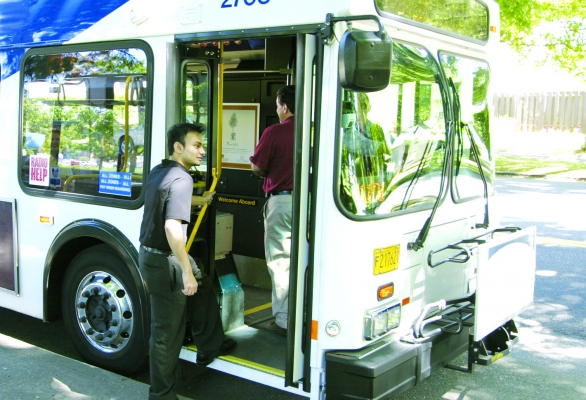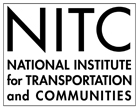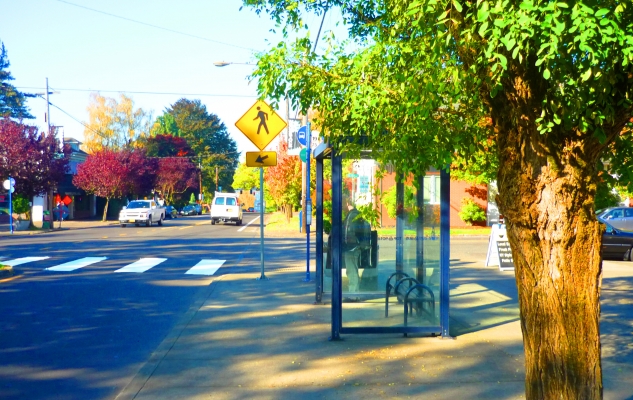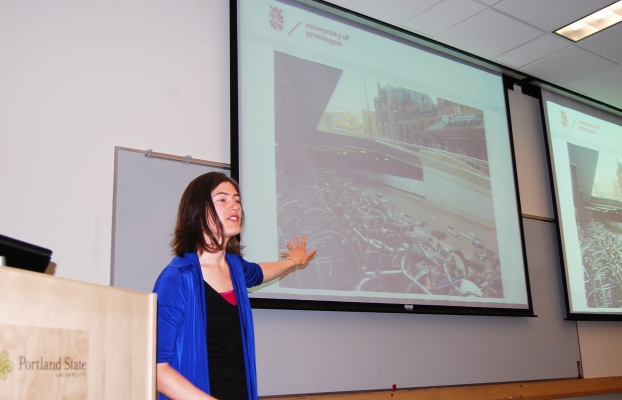Note: In advance of the Transportation Research Board's annual meeting, the biggest forum on the transportation research calendar, OTREC.us is profiling some of the researchers who will present their work.
In transit-oriented development, planners typically focus on the neighborhood within a quarter of a mile of a transit stop.
Housing and commercial developments within this "walkable zone" are thought to be the ones primarily affected by, or dependent on, the transit stop.
New research from the University of Utah expands the traditional one-quarter-mile distance away from transit stops to a broader radius of about one and one-quarter mile from a stop.
The project's principal investigator, Susan Petheram, led a team of researchers who used the Salt Lake County assessor's database to analyze property values surrounding light rail stops. Petheram is a NITC doctoral dissertation fellow and the research stems from her dissertation.
"We were seeing a certain negative impact [on property values] right around the core station area for single family homes," Petheram said. Slightly...
Read moreThe NITC program's executive committee has selected a new roster of projects for funding under the National Institute for Transportation and Communities, or NITC, program. The committee chose 10 projects, totaling $900,000, under the NITC theme of safe, healthy and sustainable transportation to foster livable communities.
The projects are national in scope and reflect priority areas including transit supply and outcomes, and pedestrian and bicyclist behavior.
Projects selected include:
- A bicycle and pedestrian miles traveled project for Washington state.
- A study that measures the effectiveness on social media on advancing public transit.
- A look into crowdsourcing the collection of data on transportation behavior.
- A national study of Bus Rapid Transit outcomes.
A complete list of projects and principal investigators is below:
- National Study of BRT Development Outcomes: Arthur Nelson and Joanna Ganning, University of Utah
- Crowdsourcing the Collection of Transportation...
Nohad Toulan’s influence on Portland State University and the wider community can be seen not only in the school bearing his name, the Nohad A. Toulan School of Urban Studies and Planning, but also in the holistic approach to transportation research and education that would help cement Portland’s innovative reputation and shape its transportation center, OTREC.
Toulan, emertitus dean of the College of Urban and Public Affairs, and his wife, Dirce, both died Monday. He was 81 and she was 78.
Toulan helped pave the way for the creation of OTREC by stressing the value of human development, said Robert Bertini, OTREC’s founding director. “Our focus on emphasizing people, on building and encouraging the development of faculty, students and collaborators outside the university, that was directly influenced by the atmosphere created by Dean Toulan,” Bertini said.
Portland State’s Urban Plaza embodies Toulan’s vision of an urban university connected with its city. There, the college’s lessons spill out into a vibrant plaza interwoven with transit and the life of Portland.
OTREC’s—and Portland State’s—reputation for multidisciplinary, collaborative transportation research grew thanks in part to Toulan’s efforts. Toulan extended Bertini, an engineering professor, a joint appointment the College of Urban and Public Affairs. “He said, ‘I need an engineer in my college,’” Bertini...
The U.S. Department of Housing and Urban Development has identified some “livability principles” which include healthy, safe and walkable neighborhoods and safe, reliable and economical transportation choices.
Transit agencies and local governments routinely use metrics to evaluate the performance of transit systems, but a uniform standard of transit data collection does not exist outside of the reporting requirements of the National Transit Database (NTD). Because of the types of data collected for the NTD, the focus of performance measurements is often on ridership and financial performance, leaving aside the question of livability.
In a new project sponsored by OTREC, Principal Investigator Marc Schlossberg, associate professor in the department of planning, public policy and management at the University of Oregon, along with co-investigators Jennifer Dill of Portland State University and Nico Larco, also of the University of Oregon, set out to create a set of tested and refined performance indicators that transit agencies across the nation can use to evaluate and improve their system performance in relation to livability goals.
Traditionally, transit systems are thought of exclusively in their wholeness: how the system serves a region,...
Read moreAt age 8, Taras Grescoe decided that his Vancouver, B.C., residential street had too many cars chugging past. So he removed them.
“I completely redesigned our city block and modeled with Monopoly hotels what it would look like without cars,” Grescoe said. “I was this 8-year-old urban planning geek in the making.”
While his career took a different path, those early transportation experiences shaped a worldview Grescoe outlines in his latest book, “Straphanger.” Grescoe will present his observations as the keynote speaker for the Oregon Transportation Summit Sept. 16.
Register for the summit through the following link:
https://trec.pdx.edu/OTRECUS/events/subpage/OTS/page1
The author of nonfiction essays and books including “Bottomfeeder: How to Eat Ethically in a World of Vanishing Seafood” Grescoe is a frequent contributor to the New York Times, the Independent and National Geographic Traveler and has written for Gourmet, Salon and Wired.
If moving from a...
An OTREC project recently took an in-depth look at the travel-time and health-related effects of a new implementation of a state of the art adaptive traffic system.
Southeast Powell Boulevard is a multimodal urban corridor connecting highway US-26 through Portland, Oregon. The corridor is highly congested during morning and evening peak traffic hours. In October 2011, an adaptive traffic system called SCATS was deployed.
The primary function of SCATS, or Sydney Coordinated Adaptive Traffic System, is to mitigate traffic congestion. Using sensors (usually inductive loops) at each traffic signal, the system tries to find the best cycle time and phasing along the corridor as traffic demand patterns change.
In this integrated multimodal study, OTREC researchers looked at the corridor’s traffic speed and transit reliability, before and after the implementation of SCATS. In addition, a novel contribution of this study was to study the link between signal timing and air quality.
To determine the impact of SCATS on traffic and transit performance, researchers established and measured performance measures before and after SCATS. The researchers used data provided by TriMet, Portland's transit authority, to compare transit times before and after SCATS as well as traffic volume data from two Wavetronix units that were installed by the City of Portland; these units collect traffic counts, speeds and classifications. For the air quality study, TriMet also...
Read moreOTREC at Portland State University welcomed Eva Heinen of the University of Groningen, The Netherlands, for a special seminar June 18. Around 40 people attended the presentation, held at the Intelligent Transportation Systems Laboratory and titled “Cycling in the Netherlands and Multi-Modality.”
Eva Heinen is assistant professor of infrastructure planning and mobility at the Department of Spatial Planning and Environment, Faculty of Spatial Sciences, University of Groningen. She earned a Ph.D. from Delft University of Technology in 2011 focusing on bicycle commuting.
Many people in Groningen and The Netherlands as a whole combine transit and bicycling for trips. A typical configuration involves cycling from home to a train station and then renting another bicycle to reach the final destination, Heinen said.
Few people take bicycles on transit, Heinen said, and buses don’t offer bike racks or other accommodations. Folding bikes, whose compact size allows for portability, are one exception, Heinen said. Electric-assist bikes are also popular, particularly with older people.
Heinen has published many papers on cycling in international and national journals and has a large international network in cycling. She spent three months at the University of California in Davis as a visiting scholar. She is a member of the editorial board of Rooilijn, a Dutch journal for science and policy in spatial planning; a member of the Bicycle Committee; co-chair of the...
Read more






